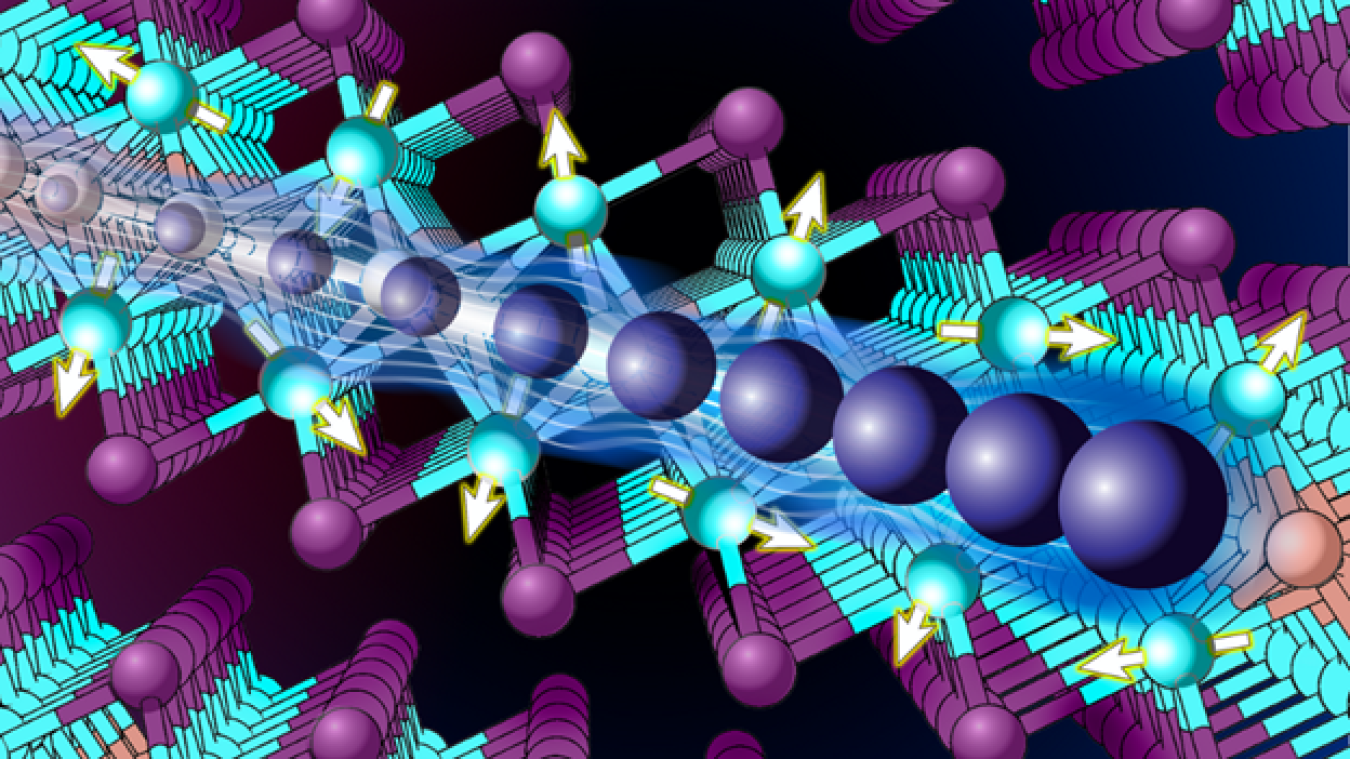The 2D material cerium silicon iodide contains the same heavy electrons responsible for heavy fermion physics, something so far seen only in 3D materials.
July 16, 2025The Science
Heavy fermion materials contain magnetic ions of elements known as lanthanides and actinides in the Periodic Table of Elements. The electrons in these heavy fermion materials get tangled and slowed down by the magnetic ions. This makes the electrons, which are a type of fermion, behave as if they had a much greater mass. This is why they are called heavy fermion materials. In conventional metals like copper, electrons effectively behave like a gas. In heavy fermion materials, the electrons instead strongly interact and behave like a sluggish liquid. Strong interactions among electrons are associated with many exotic behaviors, including superconductivity, where electrical currents have zero resistance. Heavy fermions have been studied for many years because scientists know that by tweaking the interplay between electrons and magnetic ions, they can cause the material to become a superconductor. Until now, all known heavy fermions have a 3D crystal structure, like kitchen salt or diamonds. But recently, researchers were able to make these materials in 2D form.
The Impact
Why are 2D heavy fermions so interesting? 2D materials are just a few atoms thick but extend over thousands of atoms in length and width. This geometry restricts the ways electrons can move. In conventional materials, electrons can effectively avoid each other like cars flying through 3D space. In 2D materials, electrons are forced to interact with each other, like cars in a traffic jam. Scientists think that 2D heavy fermions will be easier to tune and turn into superconductors or other quantum phases of matter, much like shrinking semiconductors to quantum dots led to new quantum phenomena, as celebrated in the 2023 Nobel Prize.
Summary
By dropping one of the dimensions in heavy fermion materials, scientists hope to uncover a new paradigm to probe novel quantum phases of matter. In a 2D material, electron-electron correlations are enhanced, and magnetic order suppressed. According to recent research and theoretical considerations, these pathways are promising for tuning the so-called Kondo interaction in heavy fermions. This would allow researchers to bring the material close to a quantum critical region where superconductivity can emerge.
2D heavy fermions are a rare class of materials that were sought for years but never found until now. By scanning crystallographic databases, researchers choose to study cerium silicon iodide (CeSiI). This material has three key ingredients: cerium atoms, which provide a magnetic moment; metallic conductivity, which is linked to freely moving electrons; and a van der Waals layered structure from which atomically thin layers can be peeled off. By using scanning tunneling microscopy, photoemission spectroscopy, and other probes of electronic structure, the researchers proved that CeSiI indeed hosts heavy fermions. Most importantly, the researchers established that the physical signatures of heavy fermions behavior were retained in thin samples made of just four layers. They also saw small shifts in the magnetic transition when comparing the thin flakes with bulk samples, suggesting that one day, it might be possible to tune the Kondo interaction just by controlling the sample thickness.
Contact
Xavier Roy
Columbia University
xr2114@columbia.edu
Abhay Narayan Pasupathy
Columbia University
apn2108@columbia.edu
Funding
This research was funded by the Department of Energy (DOE) Office of Science, Basic Energy Sciences; by the Programmable Quantum Materials center, an Energy Frontier Research Center funded by the DOE Office of Science, Basic Energy Sciences; by the National Science Foundation; and by the U.S. Air Force Office of Scientific Research. Support was also provided by an ERC synergy grant, the Swedish Research Council, eSSENCE, and STandUPP. Support also came from the Wallenberg Initiative Materials Science for Sustainability (WISE) funded by the Knut and Alice Wallenberg Foundation, by the Swedish National Infrastructure for Computing, by Grupos Consolidados, by the German Research Foundation, by the Simons Foundation Society of Fellows programme, and by the Max Planck–New York City Center for Non-Equilibrium Quantum Phenomena. The research used the National Synchrotron Light Source II at Brookhaven National Laboratory and the Spallation Neutron Source at Oak Ridge National Laboratory, both DOE Office of Science User Facilities. The research also used the National High Magnetic Field Laboratory, which is supported by the National Science Foundation and the State of Florida.
Publications
Posey, V. A., et al., Two-dimensional heavy fermions in the van der Waals metal CeSiI,Nature 625, 483–488 (2024). [DOI: 10.1038/s41586-023-06868-x]
Related Links
Columbia chemists create the first 2D heavy fermion, Columbia University Quantum Initiative news
Xavier Roy synthesizes new materials and works with other scientists to explore them, Columbia University News


